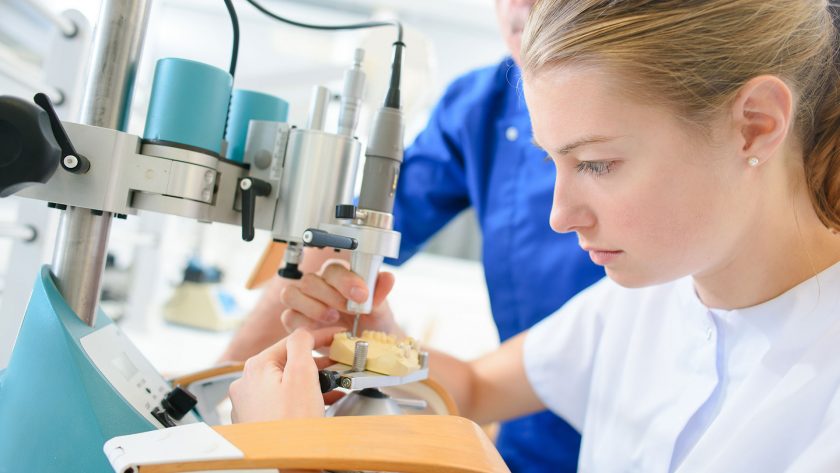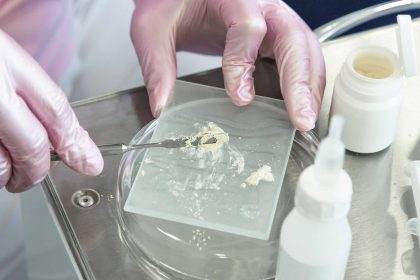Dental assisting can be a rewarding career if you like working with and assisting people in a healthcare environment. There’s plenty of demand for qualified dental assistants, and people will always need help with their teeth, so job security is good. And depending on where you live and any advanced qualifications you might have, the pay can make it worth your while — anywhere from around $33,000 per year up to $60k or more if you have certifications such as OMSA.
Requirements for becoming a dental assistant vary by state. Some states have no educational requirements at all. The dentists that employ you simply vouch for your abilities and take responsibility for your on-the-job training. Other states demand more formal education from either the Dental Assisting National Board (DANB) or the Commission on Dental Accreditation (CODA), with coursework that can take a year or more.
Many states offer a mix of alternatives for becoming a dental assistant. On the entry-level side, you can perform limited duties as an unlicensed assistant. As work experience and education helps you obtain new certifications, the number of duties you are allowed to perform increases — as does your pay.
Which certification do you need?
Whether you get your training from the DANB or CODA or directly from the dentist you work for depends largely on the state where you live. DANB will train you as a Certified Dental Assistant, while training from CODA is required by many other states. Your ultimate goal might be to become a Certified Dental Assistant (CDA) or a Registered Dental Assistant (RDA) or a dental assistant certified in any number of “expanded functions.” These expanded functions include things like coronal polishing, radiography, or application of sealants.
Requirements for dental assistants in California
As an example, let’s look at what it takes to be a dental assistant in California.
UNLICENSED DENTAL ASSISTANT — You can work as an unlicensed dental assistant in California with minimal training. Your supervising dentist will be responsible for assuring your abilities. You will only be allowed to perform basic supportive tasks that are “completely reversible” and unlikely to create hazardous conditions for the patient. Within your first year of employment, you will be required to:
- Take a course in the California Dental Practice Act
- Take an eight-hour course in infection control
- Take a course in basic life support
REGISTERED DENTAL ASSISTANT — A Registered Dental Assistant is similar to the level of Certified Dental Assistant in other states. To be certified as an RDA, you must:
- Graduate from an approved educational program. An associates program can take up to two years to complete. You will take courses in anatomy, radiation safety, dental equipment, infection control, dental law and ethics, dental software, and patient and office management.
- OR you can complete a combination of coursework and authorized work experience, usually totaling at least 15 months.
- AND you must pass the RDA General and Law and Ethics Written Exam.
- Obtain fingerprint clearance from the DOJ and FBI
REGISTERED DENTAL ASSISTANT IN EXTENDED FUNCTIONS — Registered Dental Assistants in California can expand their allowed duties by completing additional training. Expanded duties can include placement of protective interim restorations and making determinations regarding which radiographs should be performed.
- Completion of an RDAEF program for existing RDAs can take over 400 hours of coursework.
DENTAL SEDATION ASSISTANT — If you’ve completed at least twelve months of work experience as a dental assistant, you can obtain a dental sedation assistant permit by meeting additional requirements:
- Complete approved courses in infection control and the Dental Practice Act
- Complete an approved course in basic life support
- Complete an approved dental assistant sedation course
- Pass a written exam
- Obtain fingerprint clearance from the DOJ and FBI
ORTHODONTIC ASSISTANT — To obtain an orthodontic assistant permit, requirements are similar:
- Work at least twelve months as a dental assistant
- Complete approved courses in infection control and the Dental Practice Act
- Complete an approved course in basic life support
- Complete an approved orthodontic assistant course
- Pass a written exam
- Obtain fingerprint clearance from the DOJ and FBI
Continuing education requirements
Once you have obtained your RDA license, California requires additional continuing education. Your license needs to be renewed every two years to remain valid, and in order to renew it you’ll need to complete 25 hours of continuing education coursework, including refreshers on infection control, the California Dental Practice Act, and basic life support.




